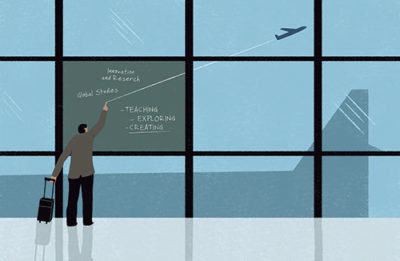With my dog-eared copy of A Field Guide to the North American Prairie, several scientific texts on prairie restoration, and Virgil’s The Georgics in my backpack, I took up residence for the month of June in the Flint Hills, an unplowed expanse of tallgrass prairie in eastern Kansas. I worked on a series of experimental poems exploring the nature of this vanishing ecosystem. Far from flat, this area is defined by steep slopes and deep-cut valleys, and it offers a rare view of grasslands like those that once dominated much of North America. Today less than 4 percent of what was once 400,000 square miles remains, and much of it is in the Flint Hills. Early drafts of my poems about this region are, by their nature, elegiac, but in revision, I trust they will find elements of repair and renewal.—Mary Pinard, professor of English

Illustration: Martin Elfman
I have many favorite memories of teaching my offshore elective, “Paris Startup Strategy,” this summer, including visiting the Louvre, the Musee d’Orsay, and the Palace of Versailles; seeing how Paris is increasingly becoming a startup hub; enjoying the city’s many great restaurants; and our final evening, a three-hour dinner cruise on the Seine that culminated with a close-up view of the Eiffel Tower as it lights up. In the class, students learn new concepts and see how they apply to the startups we visit. They also do consulting projects and get to know a bit about French culture and history. Many students tell me that the course is one of the best experiences of their Babson careers, and it helps them to get consulting jobs and internships in Paris.—Peter Cohan, lecturer of strategy
The India Office Records archives at the British Library in London has 14 kilometers of shelves full of boxes of papers and official publications on the East India Co. and the British administration of India. This August, I visited the archives for three weeks to do research for my book on the urban history of colonial India. The book is provisionally titled City Unplanned and investigates the neighborhoods of Calcutta in the early 20th century. The book argues that neighborhoods in India are more than geographic spaces; they are communities where self-government by Indians existed long before the country achieved independence in 1947. Although the archives kept me indoors, I made a point to spend time at Regent’s Park and its outdoor theater. London is a wonderful place to be in the summer.—Nabaparna Ghosh, assistant professor of global studies
My summer started with a trip to Israel for a finance conference. I was there around the opening of the U.S. embassy in Jerusalem, and although my family was concerned, I found the country in a vibrant, dynamic, and festive mood. The conference was demanding, as the crowd consisted of big names in my field, and I was presenting a relatively new paper, which examines when and why firms exercise real options. I did take time to see the bustling port of Jaffa and the metropolitan city of Tel Aviv and to float in the Dead Sea, while not forgetting to take my own pilgrimage to Jerusalem. It was a whirlwind trip before returning to campus to teach summer courses.—Jerome Taillard, associate professor of finance
